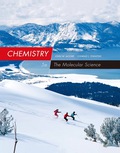
(a)
Interpretation:
The rate law for the given mechanism has to be determined.
The reaction:
The accepted mechanism:
Concept Introduction:
Steady-state approximation:
Once the steady state condition is reached, the rate of formation of the intermediate is equal to the rate of destruction of the intermediate.
(a)
Explanation of Solution
The reaction:
The accepted mechanism:
The rate determining step is the slowest step in the mechanism. Thus, the rate of the reaction is given below.
Applying the steady-state approximation on the intermediate
At steady state condition, the rate of formation of the intermediate is equal to the rate of destruction of the intermediate.
Now,
Because the rate of step
Now, the rate law can be modified as given below.
Therefore, the rate law of the reaction is
(b)
Interpretation:
Another mechanism that agrees with the same rate law has to be suggested.
Concept Introduction:
Refer to part (a).
(b)
Explanation of Solution
Another mechanism that agrees with the same rate law is given below.
The imaginary mechanism:
The rate determining step is the slowest step in the mechanism. Thus, the rate of the reaction is given below.
Applying the steady-state approximation on the intermediate
At steady state condition, the rate of formation of the intermediate is equal to the rate of destruction of the intermediate.
Now,
Because the rate of step
Now, the rate law can be modified as given below.
Therefore, the rate law of the reaction is
(c)
Interpretation:
Another mechanism that does not agree with the same rate law has to be suggested.
(c)
Explanation of Solution
Another mechanism that does not agree with the same rate law is given below.
The imaginary mechanism:
The rate determining step is the slowest step in the mechanism. Thus, the rate of the reaction is given below.
Want to see more full solutions like this?
Chapter 11 Solutions
EBK CHEMISTRY: THE MOLECULAR SCIENCE
- Define stability from both a kinetic and thermodynamic perspective. Give examples to show the differences in these concepts.arrow_forwardThe hydrolysis of the sugar sucrose to the sugars glucose and fructose, C12H22O11+H2OC6H12O6+C6H12O6 follows a first-order rate equation for the disappearance of sucrose: Rate =k[C12H22O11] (The products of the reaction, glucose and fructose, have the same molecular formulas but differ in the arrangement of the atoms in their molecules.) (a) In neutral solution, k=2.11011s1 at 27 C and 8.51011s1 at 37 C. Determine the activation energy, the frequency factor, and the rate constant for this equation at 47 C (assuming the kinetics remain consistent with the Arrhenius equation at this temperature). (b) When a solution of sucrose with an initial concentration of 0.150 M reaches equilibrium, the concentration of sucrose is 1.65107M . How long will it take the solution to reach equilibrium at 27 C in the absence of a catalyst? Because the concentration of sucrose at equilibrium is so low, assume that the reaction is irreversible. (c) Why does assuming that the reaction is irreversible simplify the calculation in pan (b)?arrow_forwardThe Raschig reaction produces the industrially important reducing agent hydrazine, N2H4, from ammonia, NH3, and hypochlorite ion, OCl−, in basic aqueous solution. A proposed mechanism is Step 1: Step 2: Step 3: What is the overall stoichiometric equation? Which step is rate-limiting? What reaction intermediates are involved? What rate law is predicted by this mechanism?arrow_forward
 Chemistry: The Molecular ScienceChemistryISBN:9781285199047Author:John W. Moore, Conrad L. StanitskiPublisher:Cengage Learning
Chemistry: The Molecular ScienceChemistryISBN:9781285199047Author:John W. Moore, Conrad L. StanitskiPublisher:Cengage Learning Chemistry: An Atoms First ApproachChemistryISBN:9781305079243Author:Steven S. Zumdahl, Susan A. ZumdahlPublisher:Cengage Learning
Chemistry: An Atoms First ApproachChemistryISBN:9781305079243Author:Steven S. Zumdahl, Susan A. ZumdahlPublisher:Cengage Learning Chemistry: Principles and PracticeChemistryISBN:9780534420123Author:Daniel L. Reger, Scott R. Goode, David W. Ball, Edward MercerPublisher:Cengage Learning
Chemistry: Principles and PracticeChemistryISBN:9780534420123Author:Daniel L. Reger, Scott R. Goode, David W. Ball, Edward MercerPublisher:Cengage Learning Chemistry & Chemical ReactivityChemistryISBN:9781337399074Author:John C. Kotz, Paul M. Treichel, John Townsend, David TreichelPublisher:Cengage Learning
Chemistry & Chemical ReactivityChemistryISBN:9781337399074Author:John C. Kotz, Paul M. Treichel, John Townsend, David TreichelPublisher:Cengage Learning Chemistry & Chemical ReactivityChemistryISBN:9781133949640Author:John C. Kotz, Paul M. Treichel, John Townsend, David TreichelPublisher:Cengage Learning
Chemistry & Chemical ReactivityChemistryISBN:9781133949640Author:John C. Kotz, Paul M. Treichel, John Townsend, David TreichelPublisher:Cengage Learning Principles of Modern ChemistryChemistryISBN:9781305079113Author:David W. Oxtoby, H. Pat Gillis, Laurie J. ButlerPublisher:Cengage Learning
Principles of Modern ChemistryChemistryISBN:9781305079113Author:David W. Oxtoby, H. Pat Gillis, Laurie J. ButlerPublisher:Cengage Learning





